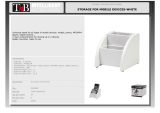
White paper | Xperia™ M
17 June 2013
On the other hand, when it comes to reading from an external SD Card, you will be able to access content
(for example, videos, photos and music) on a memory card inserted in this slot without any special
consideration since the Android system searches all available memory for content. Therefore, such
products may be regarded as supporting a fourth type of memory, called “External Card” or “SD Card”.
4. SD Card (known as “/ext_card” from a programmer’s point of view, or by other names in other Android
products) is the name for the removable SD memory card in all 2013 Sony Mobile products. As
described above, this External Card memory is generally more limited in that any application can read
from it, but many applications cannot save to this card. Only a few applications, including backup
applications and file manger applications, have the capability to save to this card.
Backing up data to different memory types
Generally, you should not save photos, videos and other personal content solely on the internal memory
of a device. If something should happen with the hardware, or if the device is lost or stolen, the data
stored on the device’s internal memory is gone forever.
In a device where an SD card reader is the main memory, it is relatively easy to take the card out and copy
all content to a PC or Mac, or to an entertainment device with a memory card slot. In a product featuring
Internal Storage as the main memory, it is not possible to physically remove the memory. Instead, any
critical or high-value content must either be copied to an external SD card by a special backup
application, transferred to remote storage over a network (mobile or Wi-Fi), or to a computer via a USB
cable.
To facilitate the transfer of data via a cable, the Xperia™ M supports the Microsoft standard, Media
Transfer Protocol (MTP), which makes it possible to easily transfer content back and forth between your
device and a Windows PC. For Apple Mac computers, a special application called Bridge for Mac is
available with built-in support for MTP. This application can be downloaded from the Xperia™ M Support
page.
Note that you do not need to back up or make a copy of applications that you have downloaded from the
Google Play™ Store. They can normally be downloaded again after you have set up your Google account
to work in a new device (or in a device where the memory has been completely erased).
Note 1:
As noted above, some Android devices, including Sony Mobile devices from 2012 and Sony Ericsson
devices from 2011 and earlier, do not use a single “Internal Storage” for both applications (and their data)
and user content. Instead, these devices use either an external SD card for user content, or a
corresponding area of internal memory to reproduce the functionality of an SD card. In such devices, there
is a fixed limit between the application area (“/data”) and the user content area (“/sdcard”), with the result
that user content can build up and reach this limit. The consequence of such a limit being reached, for
example, for the camera application, would be that no new pictures could be taken even if there was still a
considerable amount of free space in the application area (or in the user content area). In such an
instance, the download and installation of new applications would also not be possible, even if there was
enough free memory in the content area.
Note 2:
Some devices with integrated storage have abandoned the distinction between the application area and
the content area when it comes to a Factory Data Reset. As a result, there is no option in such devices to
perform a Factory Data Reset and preserve content. In such devices, all content is mandatorily and
completely deleted from the device when a reset is performed.
In contrast, Sony Mobile’s memory integration solution makes it possible to preserve user content in this
situation. Therefore, when performing a Factory Data Reset, the default action will still be to only remove
applications and their data, and an option box must be checked if all content is to be removed as well (as
might be desirable when selling the device second-hand, for instance).




















